Herbicide Application Techniques for Woody Plant Control
The encroachment of trees and other woody plants into pastures, fencerows, ditch banks, rights-of-way, and other areas is a common occurrence. These woody species can be particularly troublesome and require control since they will compromise fence integrity, vehicle safety, impede canal drainage, interfere with transmission of electricity. Additionally, some species (such as cherry trees) are highly poisonous to livestock. The aim of this publication is to detail the techniques for the removal of woody plants. For information on controlling similar species in natural areas or in forestry settings, consult UF/IFAS publications SP242, Integrated Management of Nonnative Plants in Natural Areas of Florida (https://edis.ifas.ufl.edu/wg209) and Circular 1477, Primer on Chemical Vegetation Management in Florida Pine Plantations (https://edis.ifas.ufl.edu/fr160).
Control of woody perennials can be difficult, but several control techniques are available. Mowing is a commonly used control procedure for small brush because the equipment is readily available and the results are immediate. However, this method generally provides only short-term success because it leaves live stumps and root-stocks that re-sprout. Mowing some species, like Chinese tallow, worsens the situation by replacing a single stemmed plant with a stump with multiple re-sprout stems. Another strategy that can reduce some troublesome species is fire. However, fire can be tricky to manage, and it is difficult to generate a fire with sufficient heat capacity to kill most hardwood species along fencerows, ditch banks, and other sites with low plant density.
Herbicides are often the most effective and inexpensive means of controlling woody plants. There are several application techniques that can be used to control trees and brush of various sizes. Not all brush species are equally susceptible to herbicides. Therefore, results may vary for any of these application methods, relative to brush size and species. Each application technique will be subsequently discussed.
Foliar Application
Foliar application directs an herbicide/water mixture directly onto the leaves of a plant (Figure 1). This technique can be highly effective on smaller species (6 to 8 feet in height). Auxin-type herbicides (such as triclopyr) are generally most effective early in the season, while enzyme-inhibiting herbicides (imazapyr and others) are most effective in the late summer or fall. Glyphosate is most effective in late summer or fall, prior to change in leaf color for deciduous species.
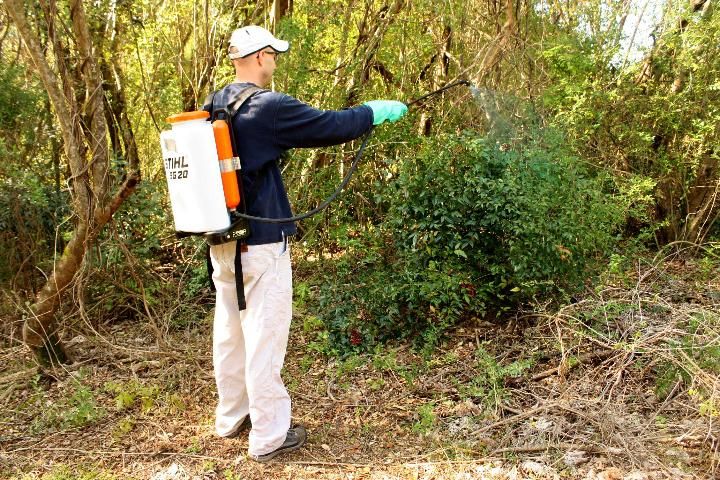
Credit: Stephen Enloe, UF/IFAS
Adequate control with foliar applications can be difficult to accomplish. This is because complete coverage of all foliage is essential for control, but over-application (which leads to spray runoff) will reduce effectiveness. Therefore, foliar applications commonly require multiple follow-up treatments before control is accomplished. It is important to control spray drift when making foliar applications. Certain desirable hardwood and crop species are highly sensitive to spray drift and can be inadvertently damaged. It is also advisable to include a tracer dye with the spray solution to ensure that some plants are not sprayed twice while others are missed entirely.
What about mowing before treatment? Mowing decreases foliage while maintaining a large root mass, making control even more difficult. If plants have been mowed, it is important to allow them to regrow to a height of 3 or 4 feet before herbicide application.
Basal Application
Basal application combines the herbicide with an oil penetrant and applies the mixture directly to the bark of a standing tree. For trees that are less than 6-inches in diameter and have smooth bark, this method is frequently successful. However, it is important that the lower 12 to 18 inches of the stem be treated on all sides with the herbicide/oil mixture (Figure 2). Adequate coverage is essential, since treating only one side of the stem will result in controlling only half of the tree. Basal applications can be made any time of the year, but control may be reduced when trees are flushing new growth in the spring. Winter is often the easiest time to do basal treatments as temperatures are cooler and many tress and surrounding herbaceous plants are dormant.
Basal applications will not provide rapid control. Herbicide injury is often not observed for several weeks after treatment, and complete control may require several months. Additionally, basal treatment is not effective on older trees greater than six inches in diameter or trees with very thick bark. For these situations, other application techniques should be employed.
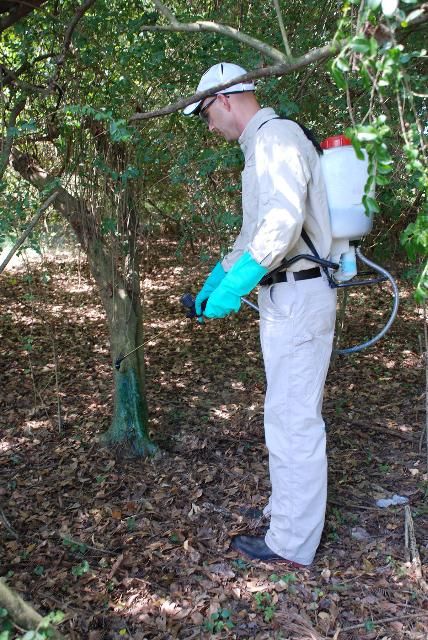
Credit: Stephen Enloe, UF/IFAS
Hack and Squirt
The hack-and-squirt technique is ideal for control of large trees that cannot be managed with basal applications. This method requires that you use a machete or hatchet to cut through the thick bark and into the sapwood. The hacks should be made at a downward angle of approximately 45 degrees. This will create a "cup" to hold the herbicide solution. If the hack does not hold herbicide solution, the treatment will not be effective. Most labels specify 0.5 to 1.0 ml of solution per hack. This is important to note, as small spray bottles commonly sold in garden supply stores may apply as much as 3.5 ml per stroke. This makes accurate application very difficult, but the most important aspect is not to overfill the hack. The recommended spacing of hacks around the circumference of the tree is specified on the herbicide label and may be described as slightly overlapping, continuous, or evenly spaced. (Figure 3) The addition of a basal oil is not recommended for this procedure.
This method of application is advantageous because it is highly selective and injury to surrounding species is not common. It can also be done at any time during the year, but effective treatment of some species in the spring can be reduced because of heavy sap flow pushing the herbicide from the cut surfaces. Finally, the hack and squirt method should only be used where dead standing trees are acceptable from an aesthetic and safety standpoint. Therefore, it is not recommended along roadsides or in parks where hazard trees cannot be tolerated.
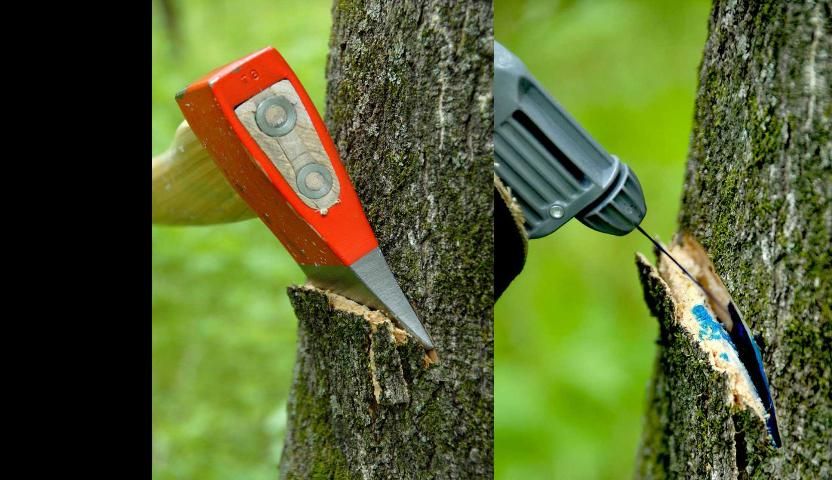
Credit: Stephen Enloe, UF/IFAS
Cut Stump
This technique is employed after cutting a tree to eliminate, or greatly reduce, resprouts from the stump or lateral roots. The herbicide should be applied to the cut surface as quickly as possible after the sawdust has been removed. If applied immediately, an herbicide/water solution is sufficient. If herbicide treatment is delayed and the cut surface has begun to dry, an herbicide/basal oil mixture must be used instead and applied to the top and around the collar of the stump.
For stumps greater than 3 inches in diameter, thoroughly wet the outer edge while avoiding herbicide runoff (Figure 4). This is because the only living tissue in larger trees is around the outer edge. Covering the entire cut surface will require more herbicide, most of which will provide little effect. For smaller stems it is appropriate to cover the entire cut surface (Figure 5). For this procedure, herbicides can be applied using a backpack sprayer, squirt bottle, or paint brush. Regardless of how the herbicide is applied, a tracer dye should be included to ensure treatment of all individual stumps.
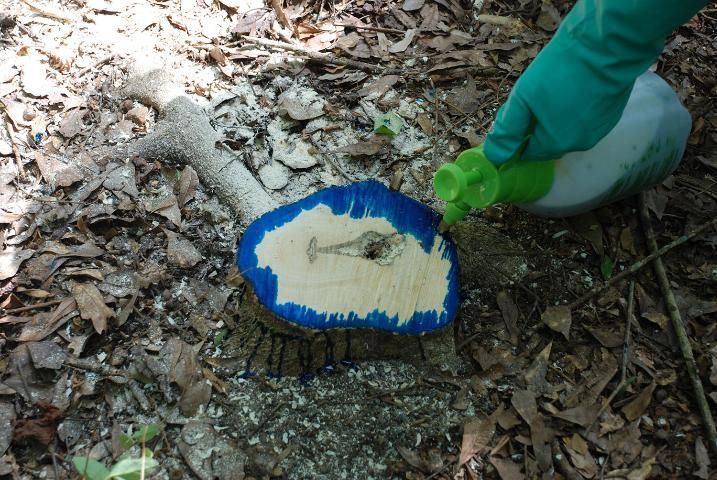
Credit: Stephen Enloe, UF/IFAS
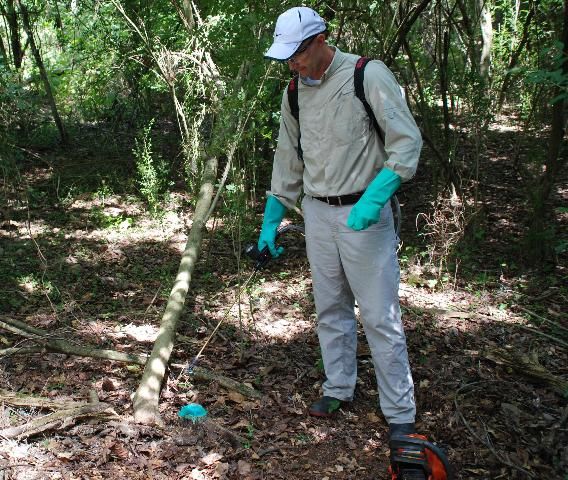
Credit: Stephen Enloe, UF/IFAS


